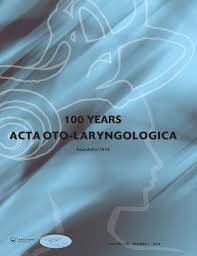Database
Publication Types:

OBJECTIVE: To evaluate the short-term stability of postoperative hearing results after tympanoplasty.
STUDY DESIGN: Prospective database study.
SETTING: Tertiary referral center.
PATIENTS: 1,367 cases of tympanoplasty I-IV were registered in the OTOKIR database between February 2004 and November 2013.
INTERVENTION: The authors included the 553 cases attending postoperative follow-ups at both 3 and 12 months.
MAIN OUTCOME MEASURE: Analysis of the changes in pure-tone average of air conduction (AC), air-bone gap, and speech reception threshold and Word Recognition Score between follow-ups were performed.
RESULTS: The overall mean change between follow-ups was 0.7, 0.5, and 0.3 dB for the AC, air-bone gap, and speech reception threshold, respectively. A majority of cases (87.7%) had a change in AC of 10 dB or less, and only 7.6% of the tympanoplasty type I cases had a decrease in AC of more than 10 dB. Of the 1,367 cases registered, 47.5% of cases were lost to follow-up at 12 months.
CONCLUSION: The changes in hearing results after tympanoplasty are minimal during 3 to 12 months after surgery. This suggests that 3-month results are as valid for reporting as 12-month results. In addition, a possible bias that compromises the validity of reported results is introduced at 12 months because half of the cases are lost to follow-up. Including results from 3-month postoperative follow-up when reporting on tympanoplasty could reduce bias in reporting and enable more centers to contribute valid results.

CONCLUSION: Current guidelines recommend reporting short-term results of > 12 months after treatment of conductive hearing loss. This study suggests that short-term hearing results after stapedotomy recorded at the 3-month follow-up are without loss of vital information compared with data from the currently recommended > 12-month follow-up. The use of 3-month data in reporting outcome could reduce the bias inherent to the loss to follow-up at 12 months.
OBJECTIVE: To investigate the stability of short-term postoperative hearing after stapedotomy for otosclerosis.
METHODS: This was a prospective database study; 371 cases with otosclerosis were registered in the database between August 2004 and June 2013. We included the 166 primary cases and 37 revision cases that had attended both follow-ups.
RESULTS: The mean changes in postoperative hearing thresholds between the 3-month and 12-month follow-up in both primary and revision cases were minimal and clinically insignificant. In all, 3-5% of primary cases and 14-16% of revision cases experienced a change of ≥ 10 dB for the worse of one or more parameters between follow-ups. Results were also stable when considering a range of traditional success criteria. Other complications following surgery were infrequent and typically resolved long term.

OBJECTIVE: To present a prospective ear surgery database and investigate the graft take-rate and prognostic factors for graft take-rate in tympanoplasty using the database.
STUDY DESIGN: Prospective database study.
SETTING: Tertiary referral center.
PATIENTS: A total of 1606 cases undergoing tympanoplasty types I to IV were registered in the database in the period from February 2004 to November 2013.
INTERVENTION: A total of 837 cases underwent myringoplasty/tympanoplasty type I.
MAIN OUTCOME MEASURE: Graft take-rate and prognostic factors (age, discharge at time of surgery, tuba function, technique, graft material, and revision surgery) for tympanoplasty type I were studied. A comparison with the graft take-rates for tympanoplasty types II to IV and/or cholesteatoma was made.
RESULTS: A user-friendly ear surgery database with fast data entry and direct import of audiometric data was developed. The graft take-rate was found to be 93.0% at 2 to 6 months and 86.6% at more than 12 months. Except for a discharging ear at the time of surgery, no significant differences using χ² test of association were found when comparing graft take-rates for different prognostic factors or more advanced tympanoplasty with or without cholesteatoma. A long-term graft take-rate overestimation of 6% was found if cases with defaulted follow-up because of early reperforation were not included.
CONCLUSION: A prospective database can be used to study prognostic factors and reduce bias in reporting the graft take-rate. Prospective databases are needed for high-quality longitudinal studies but require a continuous and daily effort of involved surgeons and therefore need to be convenient and fast to use.
